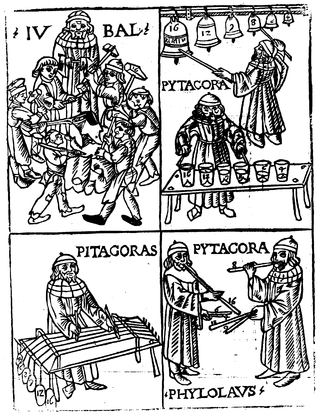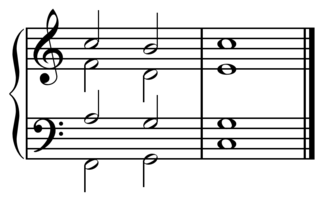
A melody, also tune, voice or line, is a linear succession of musical tones that the listener perceives as a single entity. In its most literal sense, a melody is a combination of pitch and rhythm, while more figuratively, the term can include other musical elements such as tonal color. It is the foreground to the background accompaniment. A line or part need not be a foreground melody.
Absolute pitch (AP), often called perfect pitch, is a rare ability of a person to identify or re-create a given musical note without the benefit of a reference tone. AP may be demonstrated using linguistic labeling, associating mental imagery with the note, or sensorimotor responses. For example, an AP possessor can accurately reproduce a heard tone on a musical instrument without "hunting" for the correct pitch.

Atonality in its broadest sense is music that lacks a tonal center, or key. Atonality, in this sense, usually describes compositions written from about the early 20th-century to the present day, where a hierarchy of harmonies focusing on a single, central triad is not used, and the notes of the chromatic scale function independently of one another. More narrowly, the term atonality describes music that does not conform to the system of tonal hierarchies that characterized European classical music between the seventeenth and nineteenth centuries. "The repertory of atonal music is characterized by the occurrence of pitches in novel combinations, as well as by the occurrence of familiar pitch combinations in unfamiliar environments".

Music theory is the study of the practices and possibilities of music. The Oxford Companion to Music describes three interrelated uses of the term "music theory". The first is the "rudiments", that are needed to understand music notation ; the second is learning scholars' views on music from antiquity to the present; the third is a sub-topic of musicology that "seeks to define processes and general principles in music". The musicological approach to theory differs from music analysis "in that it takes as its starting-point not the individual work or performance but the fundamental materials from which it is built."

Tonality is the arrangement of pitches and/or chords of a musical work in a hierarchy of perceived relations, stabilities, attractions and directionality. In this hierarchy, the single pitch or triadic chord with the greatest stability is called the tonic. The root of the tonic chord forms the name given to the key, so in the key of C major, the note C is both the tonic of the scale and the root of the tonic chord. Simple folk music songs often start and end with the tonic note. The most common use of the term "is to designate the arrangement of musical phenomena around a referential tonic in European music from about 1600 to about 1910". Contemporary classical music from 1910 to the 2000s may practice or avoid any sort of tonality—but harmony in almost all Western popular music remains tonal. Harmony in jazz includes many but not all tonal characteristics of the European common practice period, usually known as "classical music".
Ear training or aural skills is a music theory study in which musicians learn to identify pitches, intervals, melody, chords, rhythms, solfeges, and other basic elements of music, solely by hearing. The application of this skill is analogous to taking dictation in written/spoken language. As a process, ear training is in essence the inverse of sight-reading, the latter being analogous to reading a written text aloud without prior opportunity to review the material. Ear training is typically a component of formal musical training and is a fundamental, essential skill required in music schools.

Musical set theory provides concepts for categorizing musical objects and describing their relationships. Howard Hanson first elaborated many of the concepts for analyzing tonal music. Other theorists, such as Allen Forte, further developed the theory for analyzing atonal music, drawing on the twelve-tone theory of Milton Babbitt. The concepts of musical set theory are very general and can be applied to tonal and atonal styles in any equal temperament tuning system, and to some extent more generally than that.
In European art music, the common-practice period is the era of the tonal system. Most of its features persisted from the mid-Baroque period through the Classical and Romantic periods, roughly from 1650 to 1900. There was much stylistic evolution during these centuries, with patterns and conventions flourishing and then declining, such as the sonata form. The most prominent, unifying feature throughout the period is a harmonic language to which music theorists can today apply Roman numeral chord analysis.
Auditory imagery is a form of mental imagery that is used to organize and analyze sounds when there is no external auditory stimulus present. This form of imagery is broken up into a couple of auditory modalities such as verbal imagery or musical imagery. This modality of mental imagery differs from other sensory images such as motor imagery or visual imagery. The vividness and detail of auditory imagery can vary from person to person depending on their background and condition of their brain. Through all of the research developed to understand auditory imagery behavioral neuroscientists have found that the auditory images developed in subjects' minds are generated in real time and consist of fairly precise information about quantifiable auditory properties as well as melodic and harmonic relationships. These studies have been able to recently gain confirmation and recognition due to the arrival of Positron emission tomography and fMRI scans that can confirm a physiological and psychological correlation.

A level, also "tonality level", Gerhard Kubik's "tonal step," "tonal block," and John Blacking's "root progression," is an important melodic and harmonic progression where melodic material shifts between a whole tone above and a whole tone below the tonal center. This shift can occur to both neighboring notes, in either direction, and from any point of departure. The steps above and below the tonic are often called contrasting steps. A new harmonic segment is created which then changes the tonality but not necessarily the key.
Diana Deutsch is a British-American psychologist from London, England. She's a professor of psychology at the University of California, San Diego, and is a prominent researcher on the psychology of music. Deutsch is primarily known for her discoveries in music and speech illusions. She also studies the cognitive foundation of musical grammars, which consists of the way people hold musical pitches in memory, and how people relate the sounds of music and speech to each other. In addition, she is known for her work on absolute pitch, which she has shown is far more prevalent among speakers of tonal languages. Deutsch is the author of Musical Illusions and Phantom Words: How Music and Speech Unlock Mysteries of the Brain (2019), the Psychology of Music, and also the compact discs Musical Illusions and Paradoxes (1995) and Phantom Words and Other Curiosities (2003).
Amusia is a musical disorder that appears mainly as a defect in processing pitch but also encompasses musical memory and recognition. Two main classifications of amusia exist: acquired amusia, which occurs as a result of brain damage, and congenital amusia, which results from a music-processing anomaly present since birth.

The Andalusian cadence is a term adopted from flamenco music for a chord progression comprising four chords descending stepwise – a iv–III–II–I progression with respect to the Phrygian mode or i–VII–VI–V progression with respect to the Aeolian mode (minor). It is otherwise known as the minor descending tetrachord. Traceable back to the Renaissance, its effective sonorities made it one of the most popular progressions in classical music.
Melody type or type-melody is a set of melodic formulas, figures, and patterns.
Musical memory refers to the ability to remember music-related information, such as melodic content and other progressions of tones or pitches. The differences found between linguistic memory and musical memory have led researchers to theorize that musical memory is encoded differently from language and may constitute an independent part of the phonological loop. The use of this term is problematic, however, since it implies input from a verbal system, whereas music is in principle nonverbal.
The neuroscience of music is the scientific study of brain-based mechanisms involved in the cognitive processes underlying music. These behaviours include music listening, performing, composing, reading, writing, and ancillary activities. It also is increasingly concerned with the brain basis for musical aesthetics and musical emotion. Scientists working in this field may have training in cognitive neuroscience, neurology, neuroanatomy, psychology, music theory, computer science, and other relevant fields.
Cognitive musicology is a branch of cognitive science concerned with computationally modeling musical knowledge with the goal of understanding both music and cognition.
The Unanswered Question is a lecture series given by Leonard Bernstein in the fall of 1973. This series of six lectures was a component of Bernstein's duties as the Charles Eliot Norton Professor of Poetry for the 1972/73 academic year at Harvard University, and is therefore often referred to as the Norton Lectures. The lectures were both recorded on video and printed as a book, titled The Unanswered Question: Six Talks at Harvard.
Gordon music-learning theory is a model for music education based on Edwin Gordon's research on musical aptitude and achievement in the greater field of music learning theory. The theory is an explanation of music learning, based on audiation and students' individual musical differences. The theory takes into account the concepts of discrimination and inference learning in terms of tonal, rhythmic, and harmonic patterns.
The speech-to-song illusion is an auditory illusion discovered by Diana Deutsch in 1995. A spoken phrase is repeated several times, without altering it in any way, and without providing any context. This repetition causes the phrase to transform perceptually from speech into song.






